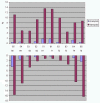Prevalence and socio-behavioral influence of early childhood caries, ECC, and feeding habits among 6-36 months old children in Uganda and Tanzania
- PMID: 22834770
- PMCID: PMC3434064
- DOI: 10.1186/1472-6831-12-24
Prevalence and socio-behavioral influence of early childhood caries, ECC, and feeding habits among 6-36 months old children in Uganda and Tanzania
Abstract
Background: Early childhood caries (ECC) is a serious problem that has remained unexplored in sub-Saharan Africa. This study aimed to identify possible socio-behavioral correlates of ECC focusing 6-36 months old children and their caretakers.
Methods: Cross sectional studies were conducted in a high fluoride rural area, Manyara, Tanzania and a low fluoride urban area, Kampala, Uganda. Totals of 1221 and 816 child - caretaker pairs attending health care facilities for growth monitoring were recruited in Manyara and Kampala, respectively. All caretakers completed face to face interviews at the health care facility. Children underwent oral clinical examination whereby ECC and Enamel hypoplasia were recorded using the dmft (WHO 1997) and the DDE index (FDI 1992).
Results: The prevalence of ECC was 3.7% in Manyara and 17.6% in Kampala. According to multiple logistic regression analyses, received oral health information from health worker was the strongest determinant of ECC in Manyara, adjusted OR 0.3, 95% CI 0.09 - 0.93. In Kampala, visible plaque, high sugar intake and presence of enamel hypoplasia associated with ECC, adjusted ORs 2.8 (95% CI 1.61- 4.95), 3.0 (95% CI 1.39 - 6.34) and 2.3 (95% CI 1.36 - 3.95).
Conclusion: Oral health education aimed at caretakers of 6-36 months, including health care workers' information regarding the detrimental consequences for oral health of frequent sugar consumption and poor oral hygiene is important for prevention of ECC in Tanzania and Uganda.
Figures



References
-
- Kumar VD. Early Childhood Caries- an insight. J Int Oral Health. 2010;2:1.
-
- Postma TC, Ayo-Yusuf OA, van Wyk PJ. Socio-demographic correlates of early childhood caries prevalence and severity in a developing country–South Africa. Int Dent J. 2008;58:91–97. - PubMed
MeSH terms
Substances
LinkOut - more resources
Full Text Sources
Medical

